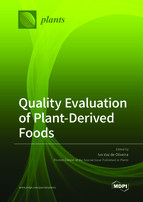Quality Evaluation of Plant-Derived Foods
A special issue of Plants (ISSN 2223-7747). This special issue belongs to the section "Phytochemistry".
Deadline for manuscript submissions: closed (30 June 2021) | Viewed by 39296
Special Issue Editor
Interests: plant physiology; food quality; food composition; agricultural and biological sciences; bioactive compounds; waste and by-product exploitation; phenolic compounds; antioxidant properties; fatty acids
Special Issues, Collections and Topics in MDPI journals
Special Issue Information
Dear Colleagues,
It is well established that preference (but not exclusivity) for plant-derived foods can result in both health and environmental benefits. However, it must be acknowledged that not all plant-derived foods present the same quality to consumers. Hence, traditional and novel tools to assure high quality standards have to be applied to these types of foods. At the same time, the definition of quality may be different from product to product, and must be studied accordingly. The composition in terms of bioactive compounds content, fat content or fatty acid profile, vitamins, carbohydrates, and volatile compounds, as well as microbial safety and sensorial characteristics, are some of the parameters that can provide insight into the quality of plant-derived foods. Of course, these types of foods are usually subjected to some kind of post-harvest processing or storage that can alter their properties. This also led to the need to study how these procedures change the characteristics of the original food.
This Special Issue “Quality Evaluation of Plant-Derived Foods” invites researchers to contribute original research or review articles that focus on the quality assessment of plant-derived foods. This includes novel approaches to this line of research, as well as the use of established methodologies to analyze novel plant foods, understudied species, or obtain new data on known plant foods.
Dr. Ivo Vaz de Oliveira
Guest Editor
Manuscript Submission Information
Manuscripts should be submitted online at www.mdpi.com by registering and logging in to this website. Once you are registered, click here to go to the submission form. Manuscripts can be submitted until the deadline. All submissions that pass pre-check are peer-reviewed. Accepted papers will be published continuously in the journal (as soon as accepted) and will be listed together on the special issue website. Research articles, review articles as well as short communications are invited. For planned papers, a title and short abstract (about 100 words) can be sent to the Editorial Office for announcement on this website.
Submitted manuscripts should not have been published previously, nor be under consideration for publication elsewhere (except conference proceedings papers). All manuscripts are thoroughly refereed through a single-blind peer-review process. A guide for authors and other relevant information for submission of manuscripts is available on the Instructions for Authors page. Plants is an international peer-reviewed open access semimonthly journal published by MDPI.
Please visit the Instructions for Authors page before submitting a manuscript. The Article Processing Charge (APC) for publication in this open access journal is 2700 CHF (Swiss Francs). Submitted papers should be well formatted and use good English. Authors may use MDPI's English editing service prior to publication or during author revisions.
Keywords
- food quality
- quality evaluation
- processing and storage
- compositional characterization
- chemometrics
- microbial food safety
- sensory characteristics







